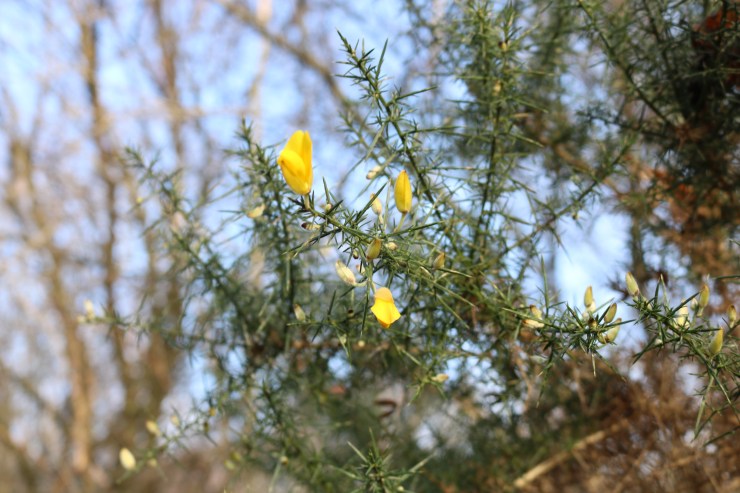
Gorse is a familiar, spiny shrub from childhood memories of the Mendip Hills in Somerset, the moors and coastal cliffs in Devon and Cornwall. Its bright yellow, pea-flowers stand out on the dreariest, winter day. During the cold, snowy winter of 2017-18, it reigned supreme as the most resilient plant in flower.

A Fab Family
Gorse is in the Fabaceae (or Leguminosae), commonly known as the pea (or legume/bean) family. There are 3 types of native Gorse in the United Kingdom. The most widespread is Ulex europaeus, more commonly known as Gorse or Furze. The other two species are Ulex gallii, Western Gorse and Ulex minor, Dwarf Gorse. These latter two Gorses have a much more local distribution. Ulex gallii can be found in coastal regions to the west, north and east to Dorset and East Anglia. Ulex minor is a rarer species found on dry to damp acid, sandy heaths in the south east of England. Location is therefore an important factor in identifying a Gorse correctly.
Ulex europaeus
Gorse is easily recognised as a spiny, evergreen shrub that can form dense thickets and stands up to 2 metres in height. The shrub owes its resilience to branched, green spines. Young plants have trifoliate leaves, i.e. three leaflets similar to Clover leaves. More mature shrubs lose their leaves. The spines are rigid and deeply grooved. By contrast, Western Gorse spines are faintly furrowed and Dwarf Gorse spines are weaker and not furrowed at all. The yellow flowers are recognisably pea-shaped flowers. They are said to smell of coconut, depending on the keenness of your sense of smell.

Land Management
Gorse’s resilience also means that it can colonise large areas and, if not kept under control, can become invasive. A maximum of 10% ground cover is regarded as appropriate on priority habitats or farmed land. Gorse often thrives in poor conditions, including in drought and very rocky soils disliked by other plants.
Fire Risk
Another issue with Gorse is that it can become a fire risk. Gorse is a relatively short-lived shrub. It holds on to its dead wood, which can then become highly flammable in dry, summer conditions. Fire used to be used to clear areas of Gorse, but this can be an unpredictable technique. In the past, Gorse was often used for burning on fires.

Bracken v. Gorse?
Gorse will regenerate in a year after being cut back. It also seeds prolifically in the soil under a shrub. Livestock, deer and a high rabbit population can help to control Gorse. The shrub can be a more beneficial plant in an environment than Bracken (Pteridium aquilinum), which can colonise new areas quickly and is basically a home-grown, native thug towards other plants. Gorse, meanwhile, is often used to fix nitrogen in poor quality soil from mining remains, and thus improves the chances of other plants to colonise an area.

Invasive Properties Abroad
Gorse is considered to be an undesirable, alien plant with invasive tendencies in many other countries. The states of California, Oregon and Hawaii in the United States, southern South America, New Zealand, Australia and South Africa all classify Gorse as invasive. It was introduced as an ornamental plant or hedge and is regarded as detrimental to native wildlife and difficult to eradicate. It seems strange to think of one of our plants being considered so invasive, at a time when they are so many concerns about non-native plants becoming invasive here.
New Zealand is trying biological controls on Gorse. A total of 7 have been introduced, but Gorse remains an issue. Biological controls do not work in isolation from land management methods.

Biodiversity
Meanwhile, back home, Gorse is considered a highly valuable plant to birds and insects. Caterpillars of the Grass Emerald (Pseudoterpna pruinata) and July Belle (Scotopteryx luridata) Moths feed exclusively on Gorse. Various beetles and insects such as the Gorse Shield Bug (Piezodorus lituratus) depend on it too. Gorse provides essential nectar in early spring and winter when little else is in flower.
The RSPB regards Gorse as essential, dense nesting sites for heathland, lowland and farmland birds. The very survival of the Dartford Warbler (Sylvia undata) is dependent upon Gorse during harsh winters.
Other named birds in relation to Gorse include:
- European Stonechat (Saxicola rubicola)
- Whinchat (Saxicola rubetra)
- Linnet (Carduelis cannabina)
- Yellowhammer (Emberiza citronella)
- Dunnock (Prunella modularis)
Other named moths in relation to Gorse include:
- Concealer Moth (Batia lambdella)
- Double-striped Pug Moth (Gymnoscelis rufifasciata)
- Case-bearer Moth (Coleophora albicosta).
West Country Folklore
Mistletoe, Viscum album, offers an excuse for a kiss at Christmas and New Year. There’s a better saying in relation to Gorse’s non-stop flowering throughout the calendar year:
When Gorse is out of bloom, kissing is out of season.
(Origin unknown)
Copyright Note
Karen does not seek or receive any commercial interest or advantage from this blog. She is not promoting any business venture. She simply loves to share fascinating facts about plants. These pages illustrate her love of plants, botany, biodiversity, gardens and creative expression. There is always so much to learn about plant diversity. This blog is designed as a showcase for photography, commentary on plants and wildlife, gardens and other places visited, horticulture and related topics. Viewpoints are her own, not those of her employer.
© Karen Andrews 2018 onwards. All rights reserved. Unauthorized use and/or duplication of this material without express and written permission from this blog’s author and/or owner is strictly prohibited. Excerpts and links may be used, provided that full and clear credit is given to Karen Andrews and BotanyKaren.net with appropriate and specific direction to the original content.
